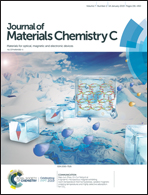Tailorable, 3D structured and micro-patternable ionogels for flexible and stretchable electrochemical devices†
Abstract
A new family of ionogels for electrochemical devices was developed from a mixture of multifunctional thiols, diacrylate and triethylamine in the presence of ionic liquid using Michael addition chemistry. Polymerization kinetic studies show that the ionic liquid not only acts as an ion source but also a co-catalyst in the polymerization. Ionogels with tailorable surface and mechanical properties were prepared using three approaches: off-stoichiometry, methacrylate addition, and dithiol chain extender addition. 3-Dimensional ionogels were constructed by bonding the flexible ionogel film together using the ionogel solution as an ionic adhesive. A tube actuator with PEDOT–PSS patterned on inner and outer wall was prepared to illustrate the potential of these ionogels with reactive surfaces. In addition, micro-patterns of the ionogels were obtained by photolithography and soft imprinting lithography. All in all, this thiol acrylate Michael chemistry provides a platform to prepare various forms (films, micro-patterns, 3-dimensional structures, and adhesive) of ionogels for the next generation of flexible electrochemical devices.



 Please wait while we load your content...
Please wait while we load your content...